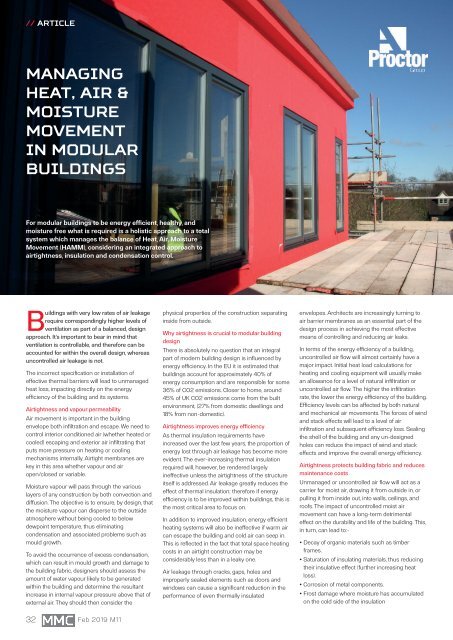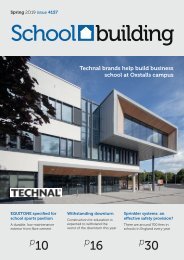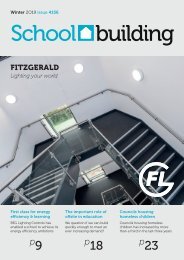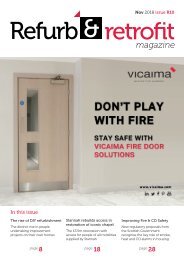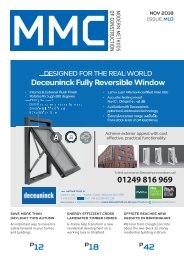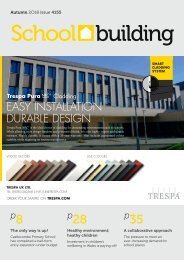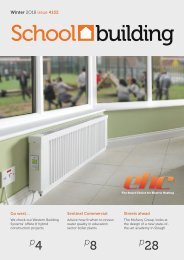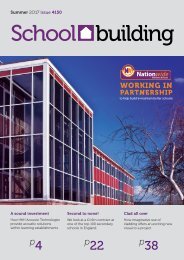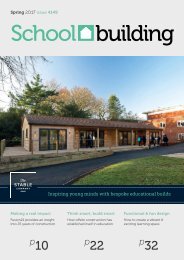a.aa MMC M11 52pp Web
Create successful ePaper yourself
Turn your PDF publications into a flip-book with our unique Google optimized e-Paper software.
Article<br />
Managing<br />
heat, air &<br />
moisture<br />
movement<br />
in modular<br />
buildings<br />
For modular buildings to be energy efficient, healthy, and<br />
moisture free what is required is a holistic approach to a total<br />
system which manages the balance of Heat, Air, Moisture<br />
Movement (HAMM), considering an integrated approach to<br />
airtightness, insulation and condensation control.<br />
Buildings with very low rates of air leakage<br />
require correspondingly higher levels of<br />
ventilation as part of a balanced, design<br />
approach. It’s important to bear in mind that<br />
ventilation is controllable, and therefore can be<br />
accounted for within the overall design, whereas<br />
uncontrolled air leakage is not.<br />
The incorrect specification or installation of<br />
effective thermal barriers will lead to unmanaged<br />
heat loss, impacting directly on the energy<br />
efficiency of the building and its systems.<br />
Airtightness and vapour permeability<br />
Air movement is important in the building<br />
envelope both infiltration and escape. We need to<br />
control interior conditioned air (whether heated or<br />
cooled) escaping and exterior air infiltrating that<br />
puts more pressure on heating or cooling<br />
mechanisms internally. Airtight membranes are<br />
key in this area whether vapour and air<br />
open/closed or variable.<br />
Moisture vapour will pass through the various<br />
layers of any construction by both convection and<br />
diffusion. The objective is to ensure, by design, that<br />
the moisture vapour can disperse to the outside<br />
atmosphere without being cooled to below<br />
dewpoint temperature, thus eliminating<br />
condensation and associated problems such as<br />
mould growth.<br />
To avoid the occurrence of excess condensation,<br />
which can result in mould growth and damage to<br />
the building fabric, designers should assess the<br />
amount of water vapour likely to be generated<br />
within the building and determine the resultant<br />
increase in internal vapour pressure above that of<br />
external air. They should then consider the<br />
physical properties of the construction separating<br />
inside from outside.<br />
Why airtightness is crucial to modular building<br />
design<br />
There is absolutely no question that an integral<br />
part of modern building design is influenced by<br />
energy efficiency. In the EU it is estimated that<br />
buildings account for approximately 40% of<br />
energy consumption and are responsible for some<br />
36% of CO2 emissions. Closer to home, around<br />
45% of UK CO2 emissions come from the built<br />
environment, (27% from domestic dwellings and<br />
18% from non-domestic).<br />
Airtightness improves energy efficiency<br />
As thermal insulation requirements have<br />
increased over the last few years, the proportion of<br />
energy lost through air leakage has become more<br />
evident. The ever-increasing thermal insulation<br />
required will, however, be rendered largely<br />
ineffective unless the airtightness of the structure<br />
itself is addressed. Air leakage greatly reduces the<br />
effect of thermal insulation; therefore if energy<br />
efficiency is to be improved within buildings, this is<br />
the most critical area to focus on.<br />
In addition to improved insulation, energy efficient<br />
heating systems will also be ineffective if warm air<br />
can escape the building and cold air can seep in.<br />
This is reflected in the fact that total space heating<br />
costs in an airtight construction may be<br />
considerably less than in a leaky one.<br />
Air leakage through cracks, gaps, holes and<br />
improperly sealed elements such as doors and<br />
windows can cause a significant reduction in the<br />
performance of even thermally insulated<br />
envelopes. Architects are increasingly turning to<br />
air barrier membranes as an essential part of the<br />
design process in achieving the most effective<br />
means of controlling and reducing air leaks.<br />
In terms of the energy efficiency of a building,<br />
uncontrolled air flow will almost certainly have a<br />
major impact. Initial heat load calculations for<br />
heating and cooling equipment will usually make<br />
an allowance for a level of natural infiltration or<br />
uncontrolled air flow. The higher the infiltration<br />
rate, the lower the energy efficiency of the building.<br />
Efficiency levels can be affected by both natural<br />
and mechanical air movements. The forces of wind<br />
and stack effects will lead to a level of air<br />
infiltration and subsequent efficiency loss. Sealing<br />
the shell of the building and any un-designed<br />
holes can reduce the impact of wind and stack<br />
effects and improve the overall energy efficiency.<br />
Airtightness protects building fabric and reduces<br />
maintenance costs<br />
Unmanaged or uncontrolled air flow will act as a<br />
carrier for moist air, drawing it from outside in, or<br />
pulling it from inside out, into walls, ceilings, and<br />
roofs. The impact of uncontrolled moist air<br />
movement can have a long-term detrimental<br />
effect on the durability and life of the building. This,<br />
in turn, can lead to:-<br />
• Decay of organic materials such as timber<br />
frames.<br />
• Saturation of insulating materials, thus reducing<br />
their insulative effect (further increasing heat<br />
loss).<br />
• Corrosion of metal components.<br />
• Frost damage where moisture has accumulated<br />
on the cold side of the insulation<br />
32 Feb 2019 <strong>M11</strong>


